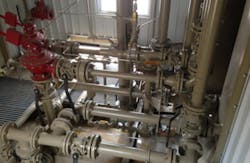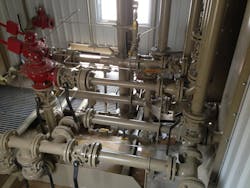Without the ability to properly measure the amount of oil, water and gas being extracted from a well, operations and reservoir engineers are significantly inhibited from being able to achieve the well knowledge needed. While the primary motivation for increased measurement accuracy is financial, there are several added benefits to the day-to-day operations of the field processing site as well.
Measurement as the Basis of Financial Transaction
The financial transaction that takes place between an oil company and a royalty owner is based on various terms in a signed lease. A royalty payment is what the landowner collects based on the amount of product that is extracted and sold from the lease. This payment could be based on a set percentage of the production value of the mineral. With advanced measurement technology monitoring the precise amounts of oil, water and gas being extracted and processed, the royalty payment system becomes far more streamlined, causing fewer royalty payment disputes and providing a firm basis for the financial transaction.
This increased measurement accuracy is beneficial for both oil companies and royalty owners. Oil companies often have to worry about the accuracy of royalty payments made to the landowner, and any discrepancies found fall on the shoulders of the oil company. Such disputes could be avoided with higher standards in measurement technology being adopted by oil companies. Royalty owners would also benefit from this technology due to the fact that separation and measurement could be tracked and recorded, providing a system of accountability for the oil company to deliver the correct allocation payment.
READ ALSO: New Technology For Cleaning Frac Water Gets Positive Marks in Water Quality Test
The Need for Advanced Measurement Technology
For many existing operations, it is costly and difficult to get reliable measurement data from multiple field processing units in a timely manner. Unreliable measurement and control technology in older separation units can lead to a variety of negative consequences for the oil company, including unnecessary waste, poor separation, errors in field processing, reduced product quality, and danger to individual users. It is important to closely monitor the production and separation in order to ensure production targets are met, the product is properly optimized, and the yield of the operation is as high as possible. The theory behind the advanced measurement retrofit technology is to provide a viable solution to companies facing similar problems.
With older separation measurement technology, field managers are often hesitant to fully trust data readouts or may not even have all of the necessary data available to monitor their operation. An unwanted byproduct of such inaccurate readouts is the waste of valuable product. For example, a separator could be malfunctioning and allocating oil in the wrong direction while displaying a false readout. With a limited reservoir and time as an important factor, operations cannot afford to use unreliable technology if such avoidable errors are being made on a regular basis.
Another negative effect of unreliable measurement technology is reduced quality of the end product. With strict standards for processed crude oil, it is unacceptable for companies to trust their pre-existing technology to deliver all of the necessary data if there is any indication that the resulting product is not of proper quality.
With the improved accuracy and reliability of the measurement provided by advanced measurement technology, field managers can expect more efficient production rates due to the correct level information and flowrate data being conveyed every time. This will allow the field manager to properly adjust all necessary equipment to the optimal settings for maximum productivity.
Another benefit of reliable measurement technology is gaining early insight into potential or existing production problems. With accurate and precise measurement data available, operators can become aware of production problems before they happen and take the necessary steps to prevent them. Should a problem occur with the technology, the data available from the advanced meters will alert the operator of the exact location and source of the problem. This added insight is an invaluable resource to companies seeking to meet tight production quotas.
Advanced Measurement Technology
A measurement technology that makes higher accuracy readings possible in well extraction processes consists of a system of Coriolis meters, level measurement, control valves, and a small PLC to capture measurement and production information at the sites and create significant operational improvements. This measurement system allows for more precise separation and measurement of oil and water at the well, and reduces the amount of oil and water that goes through the processing system without being properly accounted.
The technology itself is a retrofit kit, which can be installed to existing separation technology, such as vertical or horizontal separators. Through a series of mechanical control valves and level control systems, the technology enables users to more closely monitor and measure the output of the well and see information available at both on-site and remote terminals run by a customized PLC program provided with the kit.
With the hardware and software installed, important information becomes available to the user at the well site. It is crucial to monitor these levels at the separator in order to maintain proper separation and efficiency.
In addition to monitoring fluid levels, the technology allows users to view important system information such as ESD valve status, valve position, tank levels, tubing pressure, and casing pressure. Once again, these are important metrics that must be monitored to ensure efficiency and production quality. Through the use of the retrofit technology, it becomes easier to monitor this data.
The most important aspect of the advanced measurement technology is the measurement of water flowrate, oil flowrate, gas flowrate, and LACT information. These measurements determine the amount of oil, water and gas being separated and flowing through the field processing systems. With precise mechanical valves and level control sensors, the retrofit technology allows for accurate measurement of important and valuable processed crude oil in order to provide data for royalty payments and other financial transactions, like comingling tankage on the lease, as well as data that measures the relative productivity and value of the well site operation itself.
Finally, the technology provides options for the user to view a water/oil interface, totalize the oil flowrate, control fresh water and salt water pumps, set the VFD to run permissive, and view a variety of other SCADA information. With a complete monitoring and measurement system attached to existing separation technology, the efficiency and accuracy of a well operation significantly increases, allowing both the oil company and land owner to maximize the potential of their oil operation.
Application of Advanced Measurement Technology
The advanced measurement technology discussed here is designed as a retrofit kit, which can be installed on pre-existing separation technology lacking current Coriolis meters, sensors and other equipment. This will fully update most pre-existing measurement systems to optimize functionality. The kit includes meters, level transmitters, valves and software needed based on the specific requirements of the application.
In its application, the updated measurement technology may take the form of newer valves on the exterior of an existing separator tank, new flow control sensors on the interior of tubing or entire systems of valves and fittings required to update the system. Specific examples of updates to pre-existing systems include two-phase mechanical valves on the exterior of separator tanks and two-phase level control devices being implemented in the tubing system outside of an existing tank.
With all of the hardware in place, operators/roustabouts/electricians can easily install the electronic feedback systems, interfaces and software provided for their specific application. After all of the hardware and software is installed, inspectors can visit the job site, inspect the installation, and officially commission the technology for field use.
One example of successfully integrated advanced measurement technology comes from one of the largest oil companies currently operating in the Bakken formation, Statoil (www.statoil.com). Statoil has installed more than 100 retrofit measurement kits and has reported a return on investment of over 250 percent. In other words, the initial investment of upgrading its measurement systems to the newer technology paid off through the lack of errors, fewer tanks, lower labor costs, higher efficiency, and more accurate measurements on which to base financial transactions.
Retrofitting existing measurement technology is an excellent solution for oil drilling companies looking for an effective solution to upgrade their existing separation and measurement equipment. With newer and more precise measurement sensors, field-processing units can benefit from improved production made possible by the ease of monitoring important data. The operation and repair costs of separation devices can also be reduced through the ability of the advanced measurement technology to alert users of problems in a timely manner. Finally, the advanced measurement technology aids significantly in providing a firm basis for the financial transaction required in leases between oil companies and land owners, helping to avoid costly and time consuming disputes over royalty payments.
Ernie Reichenbachis the Business Development Manager for Oil & Gas Measurement at Valin Corporation, based in San Jose, Calif. Reichenbach has been with the company for over four years and has been selling and designing equipment in the oil and gas industry for more than 30 years.



